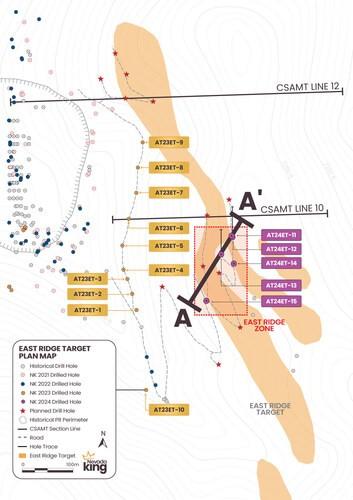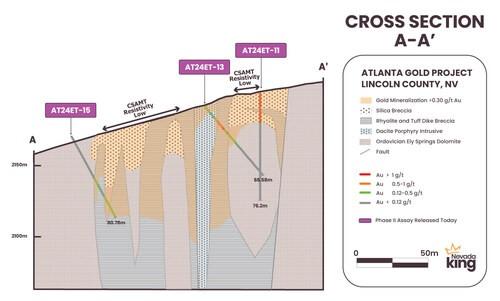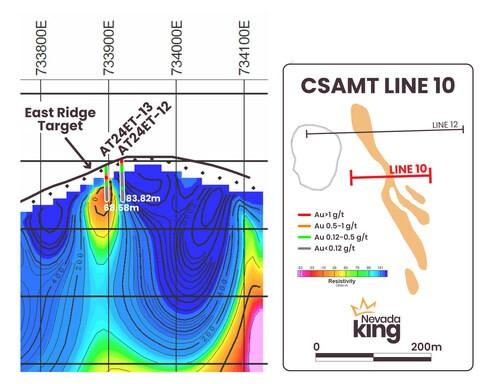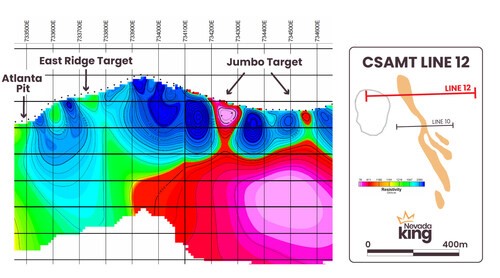
NEVADA KING MAKES AT-SURFACE OXIDE GOLD DISCOVERY AT EAST RIDGE ZONE, SHOWS POTENTIAL FOR LARGER MINERALIZED TARGETS IN NEW GEOLOGICAL SETTING AT ATLANTA

Nevada King Gold Corp. (TSX-V: NKG) (OTCQX: NKGFF) is pleased to announce results for 15 reverse circulation reconnaissance holes drilled in and around the East Ridge Target at its 5,166 hectare (51.7km2), 100%-owned Atlanta Gold Mine Project, located in the prolific Battle Mountain Trend 264km northeast of Las Vegas, Nevada. Drilling at the ERT commenced in June with five holes located to test coincident geophysical and geochemical anomalies. A fence of 10 holes were also drilled between the ERT and the Atlanta Resource Zone. The ERT covers a low resistivity zone that measures 100m-wide, strikes 1,000m north-south and is located 300m east of the historical Atlanta Pit and resource zone.
Highlights:
- First pass drilling at the ERT has led to the discovery of an at-surface oxide gold zone called the East Ridge Zone that is located within the overall ERT area and includes the highlight interval of 1.32 g/t Au over 22.9m in AT24ET-11 (Figure 1). Gold mineralization was intercepted in five of today’s widely spaced holes over a 100m x 200m area, with mineralization hosted in silica breccia and mineralized intrusive rock down to a depth of 57m where it remains open (Figure 2). The ERZ represents the first satellite gold discovery made at Atlanta and demonstrates the project’s district-scale potential.
| Hole No. | From (m) | To (m) | Interval (m) | Au (g/t) | Ag (g/t) |
| AT24ET-11 | 0 | 22.9 | 22.9 | 1.32 | 3.5 |
| AT24ET-12^ | 0 | 22.9 | 22.9 | 0.33 | >1.0 |
| AT24ET-13^ | 12.2 | 33.5 | 21.3 | 0.53 | 2.35 |
| AT24ET-14 | 6.1 | 12.2 | 6.1 | 0.36 | 1.3 |
| AT24ET-15^ | 42.7 | 79.3 | 36.6 | 0.16 | 1.7 |
| Table 1. Highlight holes released today. True mineralized thickness estimated to be 97% of reported intercept length for vertical holes and 68% for angle holes. ^Denotes -45o dip angle hole. | |||||
- Referring to Figures 3-4, the mineralized intercepts in today’s holes correlate well with the low resistivity zone from the Company’s CSAMT geophysical survey that outlines near-vertical bodies of low resistivity, interpreted as mineralized high-angle intrusions (shown in red) cutting up through a highly resistive, unmineralized dolomite sequence (shown in blue). Ten vertical reconnaissance holes (AT23ET-1-AT23ET-10) arranged along a north-south line between the ERT and the Atlanta resource zone were designed to check for a possible low-angle connection between both mineralized zones. All ten holes were sited within the high resistance zone separating the ERT and resource zone, and the lack of significant gold values in these holes further supports the Company’s CSAMT interpretation above.
- Each of today’s five highlight holes intercepted high-angle, intrusive-related gold mineralization bounded laterally by massive, impermeable dolomite. This geological setting differs substantially from that seen in the Atlanta resource zone, where gold occurs along and immediately above a low-angle unconformity separating dolomitic and quartzitic basement rocks from overlying volcanic rocks. The new geological setting seen at the ERT lends itself to numerous additional targets identified by the CSAMT data throughout the Atlanta district, including the much larger Jumbo Target located a further 300m east of the ERT, which measures 400m wide by 3,000m north-south (Figure 5).
- Current drilling is testing the northern and southern extensions of the ERZ along the geophysical anomaly as well as for depth and width of mineralization. A full technical discussion detailing today’s holes and their significance can be found in the Technical Discussion section below.
Cal Herron, Exploration Manager of Nevada King, commented, “Today’s discovery of the ERZ marks a major milestone for our exploration efforts at Atlanta. Aside from representing the first satellite gold zone discovered in the district, it was primarily identified based on a geophysical anomaly. We have long hypothesized that Atlanta has district-scale potential to host multiple gold zones. However, these potential zones are hard to find when relying on geology alone, as they are obscured by extensive alluvium and basement rock cover throughout the district. Today’s discovery gives us the confidence that we can utilize geophysics as an important tool to hone in on additional mineralized zones. This opens up numerous areas within the Atlanta District where very similar anomalies are seen in the CSAMT data but on a much larger scale. A good example is the large low resistivity zone (red color) shown in Figure 3 immediately east of the ERZ that projects upward into the carbonate sequence from a much larger low resistivity body beneath it. The dikes and mineralization within the ERT appear to originate from this large, deeper resistivity low. The horn-shaped low resistivity zone (red color) at the far right of Figure 4 is potentially the upper portion of a large igneous mass intruding upward into the carbonate sequence and could represent a mineralized zone similar to the ERZ, albeit on a larger scale.
“By comparing the past and present drill hole locations to the inferred intrusive pattern found in our CSAMT data (Figure 5), it is clear that very little of this prospective ground has been drill-tested. As our 2024 reconnaissance exploration program progresses, we now have numerous targets to chase in all directions from the current resource zone, and considering the strong intrusive tie to Au/Ag mineralization, the Company is well positioned to make more new discoveries.”
| Hole No. | From (m) | To (m) | Interval (m) | Au (g/t) | Ag (g/t) |
| AT23ET-1 | 0 | 4.6 | 4.6 | 0.29 | 1.1 |
| AT23ET-2 | 0 | 59.5 | 59.5 | <0.04 | <0.5 |
| AT23ET-3 | 0 | 6.1 | 6.1 | 0.14 | 0.675 |
| AT23ET-4 | 1.5 | 3.0 | 1.5 | 0.10 | <0.5 |
| AT23ET-5 | 0 | 61.0 | 61.0 | <0.04 | <0.5 |
| AT23ET-6 | 13.7 | 15.2 | 1.5 | 0.13 | <0.5 |
| AT23ET-7 | 27.4 | 29.0 | 1.5 | 0.10 | <0.5 |
| AT23ET-8 | 0 | 77.7 | 77.7 | <0.04 | <0.5 |
| AT23ET-9 | 0 | 111.3 | 111.3 | <0.04 | <0.5 |
| AT23ET-10^ | 10.7 | 35.1 | 24.4 | 0.05 | <0.5 |
| AT24ET-11 | 0 | 22.9 | 22.9 | 1.32 | 3.5 |
| AT24ET-12^ | 0 | 22.9 | 22.9 | 0.33 | >1.0 |
| AT24ET-13^ | 12.2 | 33.5 | 21.3 | 0.53 | 2.35 |
| AT24ET-14 | 6.1 | 12.2 | 6.1 | 0.36 | 1.3 |
| AT24ET-15^ | 42.7 | 79.3 | 36.6 | 0.16 | 1.7 |
| Table 2. All holes released today. True mineralized thickness estimated to be 95-100% of reported intercept length for vertical holes and 65-70% for angle holes. ^Denotes -45o angle hole. | |||||
Technical Discussion
- As seen in Figure 2, higher grade Au mineralization is hosted in silica breccia adjacent to intrusive dikes and within strongly silicified rhyolitic tuff dike breccia zones hosting small quartz veinlets, while lower grade mineralization occurs within argillized tuff dikes and variably silicified dolomite.
- Vertical hole AT24ET-11 (1.32 g/t Au over 22.9m) and angle hole AT24ET-12 (0.33 g/t over 22.9m) were collared along the eastern margin of the CSAMT anomaly. Both holes encountered mineralization at the surface that extend to 23m depth, where Au values dropped quickly when the massive dolomite bounding the eastern side of the intrusive zone was penetrated.
- Angle hole AT24ET-13 collared in a weakly mineralized dacite tuff dike (average 0.176 g/t Au over 15.2m) and encountered higher-grade mineralization (0.53 g/t over 21.3m) within a silicified rhyolite tuff dike breccia and adjacent silicified/decalcified dolomite from 15.2m to 33.5m (10.7m and 23.7m vertical depths). Gold values drop rapidly with depth in the adjacent massive dolomite.
- Vertical hole AT24ET-14 (6.1m @ 0.33 g/t Au) tested an argillized dacitic intrusion exposed in the drill road 52m south of AT24ET-11 along the eastern margin of the CSAMT anomaly. Gold enrichment occurs within a rhyolitic tuff dike breccia at 6m depth directly beneath the dacite and decreased rapidly as the hole entered the adjacent massive dolomite bounding the eastern side of the intrusive zone.
- Angle hole AT24ET-15 (36.6m @ 0.164 g/t Au) was sited to test the western margin of the CSAMT anomaly. The hole collared in unmineralized, massive dolomite and hit the mineralized intrusive zone at 41m depth (29m vertical depth). This hole stayed in weakly mineralized rhyolitic tuff dike breccia to the TD depth of 81m (57.2m vertical depth) and bottomed in 0.087 g/t Au. This long gold intercept reveals the presence of mineralized intrusive down to a minimum 57.2m depth, which correlates well with the low resistivity zone forming the ERZ CSAMT anomaly.
- Figure 3 plots the traces of angle holes AT24ET-12 and AT24ET-13 onto a sectional view of the East Ridge CSAMT anomaly along Line 10. AT24ET-13 clearly correlates the altered, mineralized igneous intrusions and associated silicified/decalcified dolomite with the near-vertical low resistivity zone (orange color) forming the CSAMT anomaly. The dark blue highly resistive regions are clearly unaltered and unmineralized massive dolomite that served as a lateral constraint on the mineralization, hence concentrating the gold within a confined space. The paragenesis for gold mineralization in this geologic setting is evident: dacitic intrusions and associated acidic, magmatic fluids originating from a much larger magmatic body at depth stoped upward into the massive dolomite country rock toward the surface along pre-existing faults, decalcifying the adjacent and overlying dolomite in the process and creating a shell of collapse breccia around the intrusive zone. This initial igneous and alteration event was followed by intrusion of more felsic, rhyolitic intrusions and associated gold-rich fluids along the same structural pathways, which resulted in a larger area of collapse brecciation, silicification, and gold mineralization within the intrusive rocks and adjacent collapse breccia.
Evidence for a Porphyry-Related Gold Deposit at Atlanta
- The term “porphyry-related deposit” refers to a metallic deposit that is genetically associated with a generally deeper, metalliferous, volatile (water and gas) rich magma that rapidly pushes its way up toward the earth’s surface and in the process concentrates metals and fluids (mainly water) at and near the top of the magma column. As the magma chills into solid rock, late stage porphyritic dikes together with water containing dissolved metals are injected upward and outward from the cooling igneous stock into surrounding, cooler wallrock and potentially all the way upward to the surface. Upon cooling in a generally lower pressure environment and likely mixing with meteoric water closer to the surface, the metals contained in the hydrothermal fluid precipitate and are deposited in the intrusive dikes and adjacent permeable and possibly reactive wallrock, thus forming a porphyry-related deposit that frequently looks nothing like the parent porphyry deposit. This connection between porphyry-related deposits and a deeper porphyry deposit is important because the parent magma for both deposit types possesses the ability to generate large quantities of heat, water/gas, and metals over a long period of time – all of which are necessary to form large base and precious metals deposits. Such porphyry-related deposits often form in caldera settings (like Atlanta) where recurrent intrusive activity within and/or around the caldera margin can produce multiple deposits, ranging from deep porphyry Cu/Mo to surficial hotspring-type gold systems in different parts of the caldera at the same time. With increasing distance from the porphyry source, the related but more distal deposits tend to take on different geological characteristics peculiar to the immediate geologic environment in which they form, but usually some evidence of the porphyry “mother” source is seen in the distal deposits, such as high copper or molybdenum gold deposits that are related to the deeper porphyry copper/molybdenum deposits. Porphyry and porphyry-related metal deposits form a large proportion of global base and precious metals production and are important components in many major mining company’s portfolios. The Atlanta District is a good example of a porphyry-type environment in a caldera setting where intrusive and associated volcanic resurgence occurred over a span over several million years. Drilling within the Atlanta resource zone and along the ERZ has revealed a strong connection between gold/silver mineralization and shallow (subvolcanic) intrusive rocks that most likely originated from porphyry-type sources at depth, as outlined below.
- Within the Atlanta resource zone, volcanic rocks deposited on top of dolomite and quartzite basement rocks formed a gently west-dipping unconformity that served as the primary host for gold mineralization. High-angle faults channeled vesiculated igneous dikes (tuff dikes) and mineralizing fluids up into the unconformity where they spread laterally, and in places like the West Atlanta Graben Zone, moved upward into the volcanic sequence. At the ERZ we find the same high angle, vesicular intrusive bodies and associated gold mineralization, but its structural setting is very different in that dolomite basement rocks laterally bound high-angle, dike-like vesicular intrusions that stoped upward into the carbonate sequence from a magmatic and hydrothermal source at depth. Intrusion of late stage, rhyolitic tuff dikes along this high-angle structural corridor appears to have occurred at the same time as the alteration and gold mineralization, which strongly suggests a genetic relationship between mineralization and the dikes. Even though the structural settings are very different, the very close relationship in time and space between gold mineralization and intrusion of porphyritic, vesicular dacitic and rhyolitic dikes, sills, and small plugs in both the resource zone and ERZ argues strongly for the presence of an intrusive-dominated, porphyry-related gold system. Further evidence is seen in the strong molybdenum mineralization (>1000 ppm Mo) that occurs in and below the gold zone within the West Atlanta Graben Zone together with reported gold tellurides found in silica breccia along the Atlanta Mine Fault Zone. This porphyry tie is further supported by the spatial coincidence of gold-mineralized, shallow intrusions with the deeper, much larger intrusive bodies inferred from the CSAMT data (Figure 5). This structural tie to a deep intrusive body has been drill-verified at the southwestern corner of the resource zone where several deep historical and Nevada King holes have drilled into a large, dacite porphyry dike or elongate dome that is also exposed at the surface bounding the Quartzite Ridge Target’s western margin. This part of the resource zone is also where the highest molybdenum values occur. The lack of obvious porphyry Cu-Mo indicators, like presence of potassic alteration (K-spar/ biotite) and calc-silicate alteration in the carbonates, tells us Atlanta is still far from any potential porphyry source. Additionally, the Company possesses no isotope or fluid inclusion work to directly verify a porphyry tie at depth. However, the lithologic and mineralogical data, the geophysical data (gravity, drone magnetics, CSAMT), and the deep drill holes at the SW corner of the resource zone all indicate a strong structural tie to a porphyry-type source at depth. We see this same relationship between gold mineralization and shallow rhyolitic intrusions elsewhere in the Atlanta District, most commonly in the Quartzite Ridge Target and Western Knolls Target (4km west of the resource zone), which provides additional evidence for the presence of one or more porphyry intrusions at depth that powered a district-scale hydrothermal system. This shallow porphyry tie to gold mineralization at Atlanta opens up the entire district for finding additional Au deposits. Utilizing our gravity, magnetic, and CSAMT datasets, identification of deep-seated intrusive plumbing underlying the Atlanta District has provided Nevada King with a fairly accurate roadmap for pursuing additional porphyry-related targets well outside the current resource zone.
QA/QC Protocols
All RC samples from the Atlanta Project are split at the drill site and placed in cloth and plastic bags utilizing a nominal 2kg sample weight. CRF standards, blanks, and duplicates are inserted into the sample stream on-site on a one-in-twenty sample basis, meaning all three inserts are included in each 20-sample group. Samples are shipped by a local contractor in large sample shipping crates directly to American Assay Lab in Reno, Nevada, with full custody being maintained at all times. At American Assay Lab, samples were weighted then crushed to 75% passing 2mm and pulverized to 85% passing 75 microns in order to produce a 300g pulverized split. Prepared samples are initially run using a four acid + boric acid digestion process and conventional multi-element ICP-OES analysis. Gold assays are initially run using 30-gram samples by lead fire assay with an OES finish to a 0.003 ppm detection limit, with samples greater than 10 ppm finished gravimetrically. Every sample is also run through a cyanide leach for gold with an ICP-OES finish. The QA/QC procedure involves regular submission of Certified Analytical Standards and property-specific duplicates.
Qualified Person
The scientific and technical information in this news release has been reviewed and approved by Calvin R. Herron, P.Geo., who is a Qualified Person as defined by National Instrument.
About Nevada King Gold Corp.
Nevada King is the third largest mineral claim holder in the State of Nevada, behind Nevada Gold Mines (Barrick/Newmont) and Kinross Gold. Starting in 2016, the Company has staked large project areas hosting significant historical exploration work along the Battle Mountain trend located close to current or former producing gold mines. These project areas were initially targeted based on their potential for hosting multi-million-ounce gold deposits and were subsequently staked following a detailed geological evaluation. District-scale projects in Nevada King’s portfolio include (1) the 100% owned Atlanta Mine, located 100km southeast of Ely, (2) the Lewis and Horse Mountain-Mill Creek projects, both located between Nevada Gold Mines’ large Phoenix and Pipeline mines, and (3) the Iron Point project, located 35km east of Winnemucca, Nevada.
The Atlanta Mine is a historical gold-silver producer with a NI 43-101 compliant pit-constrained resource of 460,000 oz Au in the measured and indicated category (11.0M tonnes at 1.3 g/t) plus an inferred resource of 142,000 oz Au (5.3M tonnes at 0.83 g/t). See the NI 43-101 Technical Report on Resources titled “Atlanta Property, Lincoln County, NV” with an effective date of October 6, 2020, and a report date of December 22, 2020, as prepared by Gustavson Associates and filed under the Company’s profile on SEDAR+ (www.sedarplus.ca).
| Resource Category | Tonnes
(000s) |
Au Grade
(ppm) |
Contained Au Oz |
Ag Grade
(ppm) |
Contained Ag Oz |
| Measured | 4,130 | 1.51 | 200,000 | 14.0 | 1,860,000 |
| Indicated | 6,910 | 1.17 | 260,000 | 10.6 | 2,360,000 |
| Measured + Indicated | 11,000 | 1.30 | 460,000 | 11.9 | 4,220,000 |
| Inferred | 5,310 | 0.83 | 142,000 | 7.3 | 1,240,000 |
| Table 3. NI 43-101 Mineral Resources at the Atlanta Mine | |||||

Figure 1. Plan view of ERZ showing locations of reported reconnaissance drill holes. The composited low resistivity CSAMT anomaly highlighted in orange trends NNW for about 1,000m and corresponds with intrusive dikes and associated decalcification in the surrounding dolomite that provided the plumbing system for gold mineralization. The trend of the anomaly is very similar to that of the main pit resource zone. (CNW Group/Nevada King Gold Corp.)

Figure 2. Drill section A-A’ across the central portion of the ERZ showing gold mineralization in relation to the silica breccia zone and high-angle intrusions. Oxidized Au mineralization is largely hosted within silicified and clay-altered rhyolitic intrusions and adjacent silicified dolomite. Depth of mineralization within the intrusive rocks is currently unknown. (CNW Group/Nevada King Gold Corp.)

Figure 3. Looking north at CSAMT Line 10 with ERZ anomaly (orange), indicating low-resistivity rock types – silicified/argillized Tertiary intrusions & variably silicified and decalcified dolomite. Blue indicates highly resistive, unaltered Paleozoic carbonate basement rocks. Horn-shaped low resistivity zone at far right is potentially upper portion of large igneous mass intruding upward into carbonate sequence and could represent a mineralized zone similar to the ERZ, albeit on a larger scale. (CNW Group/Nevada King Gold Corp.)

Figure 4. Looking north at CSAMT Line 12 with ERZ anomaly (green), indicating low-resistivity rock types – silicified/argillized Tertiary intrusions and decalcified dolomite. Blue indicates highly resistive, unaltered Paleozoic carbonate basement rocks. Red colors to east of ERZ in new Jumbo Target suggest large intrusive mass underneath Paleozoic carbonate cover with plumes intruding up through the carbonate carapace, similar to that seen in ERZ but on a much larger scale. (CNW Group/Nevada King Gold Corp.)

Figure 5. Plan Map shows distribution of major structural features as indicated by deep CSAMT low resistivity responses in relation to exploration targets and drilling done to date (includes historical and NKG holes). Deep drill holes reveal these CSAMT anomalies to be igneous intrusions and associated alteration of adjacent carbonate basement rocks. The Atlanta resource zone occurs near a sharp flexure in the basement structure that is mimicked by the low resistivity zones to the west and east. (CNW Group/Nevada King Gold Corp.)
MORE or "UNCATEGORIZED"
Kuya Silver Confirms High-Grade Silver-Gold Vein Mineralization at Umm-Hadid with Initial Drill Results up to 1483.9 g/t AgEq over 2 Metres
Kuya Silver Corporation (CSE: KUYA) (OTCQB: KUYAF) (FSE: 6MR1) is... READ MORE
First Phosphate Closes Final Tranche of Oversubscribed Private Placement
First Phosphate Corp. (CSE: PHOS) (OTCQX: FRSPF) (FSE: KD0) is... READ MORE
GFG Receives Final Payment from the Sale of its Rattlesnake Hills Gold Project
GFG Resources Inc. (TSX-V: GFG) (OTCQB: GFGSF) announces that i... READ MORE
Goliath Receives $1,730,882 Through Warrant Exercises, Inclusive Of Crescat Capital A Longtime Strategic And Cornerstone Shareholder
Goliath Resources Limited (TSX-V: GOT) (OTCQB: GOTRF) (FSE: B4IF)... READ MORE
Robex Pours First Gold at Kiniéro on Schedule and Budget
Highlights: Gold bar weighing 2.64 kilograms (85 oz) poured in th... READ MORE












